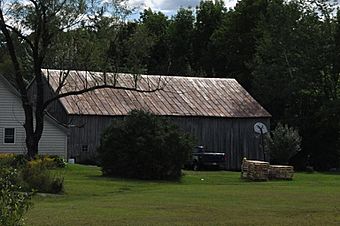Barn on Lot 8, Range G facts for kids
Quick facts for kids |
|
|
Barn on Lot 8, Range G
|
|
 |
|
| Location | 816 Foster Hill Road, Freeman Township, Maine |
|---|---|
| Area | less than one acre |
| Built | c. 1825, 1899 |
| NRHP reference No. | 11000581 |
| Added to NRHP | August 24, 2011 |
The Barn on Lot 8, Range G is a very old and special barn located in a quiet, rural part of Franklin County, Maine. This barn was built in two main stages. The first part was put up around 1825, and the second section was added in 1899. It's famous for its unique design, which shows a clever way to make a traditional barn much bigger. Because of its historical importance, the barn was added to the National Register of Historic Places in 2011.
Contents
Where is This Barn?
This historic barn stands on the west side of Foster Hill Road. This road is also known as Maine State Route 145. The barn is in Freeman Township. This area used to be a town, but it was disincorporated in 1934. It's about 15 miles (24 km) north of Farmington.
The land where the barn sits has always been called Lot 8, Range G. It's not clear who owned the land before 1825. Behind the barn, there's an old house that also dates back to the early 1800s. The house has been changed over time, but the barn remains very original. The buildings are surrounded by fields and old orchards, with woods beyond them.
What Does the Barn Look Like?
The barn is a long, rectangular building. It is about 65 feet (20 meters) long and 36 feet (11 meters) wide. It has a roof that slopes down on two sides, called a gable roof. The barn faces east to west, so it stands sideways to the road.
The Two Parts of the Barn
The eastern part of the barn is the oldest section. It is about 46 feet (14 meters) long and was built around 1825. This part is a traditional English barn. A large sliding door, about 12 feet (3.7 meters) wide, is in the middle of its north side. This was the original entrance.
The western section was added in 1899. It has a second entrance, which is a hinged door, on its western end. There are also two smaller doors on the east side of the barn. You can see windows on the east, south, and west sides, but they are not placed in a regular pattern. The outside walls are covered with vertical wood siding, which was likely replaced in the 1900s. The barn's roof is made of steel.
Inside the Barn
When you go inside, you can clearly see the two different parts of the barn. The older section, built in 1825, uses large timbers cut by hand. These timbers were joined together using a method called "scribe-rule joinery." This means each piece was carefully shaped to fit perfectly with the next.
The newer section, added in 1899, uses timbers that were cut by saws. These were joined using "square-rule joinery," a more modern method. The older part of the barn has a main walkway that runs north to south, with three sections on each side.
A Unique Expansion
What's really special about this barn is how the new section was added. The middle section on the west side of the old barn was changed. It became a passage leading into the new part. To make this happen, two of the old barn's main support posts were moved. They were placed on either side of this new passage.
This way of expanding a barn was very unusual. As of 2011, when the barn was nominated for the National Register, this type of alteration had not been seen anywhere else in Maine. Usually, if farmers wanted more space, they would either:
- Build a second English barn and attach it. But this would create two separate walkways inside.
- Or, they would change the old barn's doors to the ends and move all the central posts to create one long central walkway.
In this barn, only one side was changed. This created a unique T-shaped walkway inside. It's a great example of how people found creative solutions to make their buildings work better for them.



